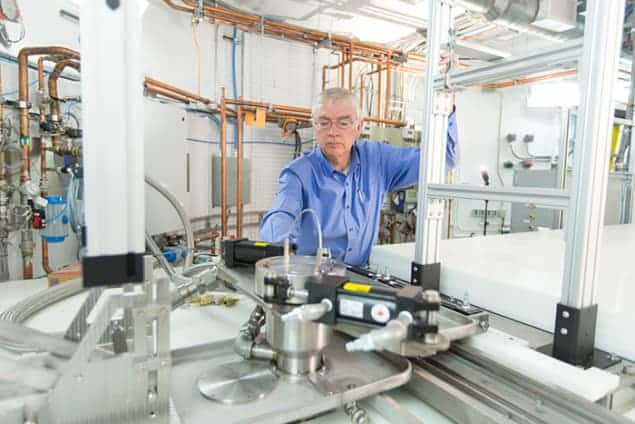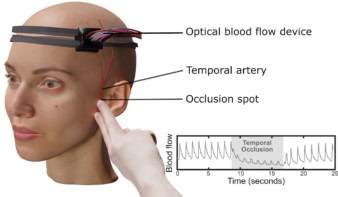
The first commercial shipment of medical isotopes produced using a new particle-accelerator-based technique has been made by scientists at the Canadian Light Source (CLS). Molybdenum-99 (Mo-99) decays to create technetium-99m (Tc-99m), which is used to tag radiopharmaceuticals and plays a unique and vital role in medical imaging. Unlike nuclear reactors, which currently make most of the world’s Mo-99, the system is small enough to be deployed within a large hospital and could thereby improve the supply of the short-lived isotopes.
The material is made at the Medical Isotope Project (MIP) facility at the CLS, which is located at the University of Saskatchewan in Saskatoon. According to Mark de Jong, director of accelerators at the CLS, the facility is the first of its kind anywhere in the world, and uses a small high-power industrial electron linear accelerator to produce a flux of high-energy X-rays through bremsstrahlung radiation. The X-rays strike a target made of enriched Mo-100, in the process “knocking out” a neutron from the nuclei of some of the target atoms to produce Mo-99.
No fission required
“The main advantage of this method is the complete avoidance of any use of uranium or fission, with all the problems that arise from both volatile short-lived isotopes, as well as disposing of the long-lived radioactive waste,” says De Jong.
After several days of irradiation at the CLS facility, the target is shipped 800 km to the Winnipeg Health Sciences Centre’s Radio-Pharmacy Department, where it is dissolved and the Tc-99m is extracted. Transport across long distances is possible because Mo-99 has a half-life of 66 hours, but significant losses do occur. The half-life of Tc-99m is just 6 hours, so it must be produced as near as possible to where it will be used.
De Jong says that future implementations will not necessarily require such long-distance shipping. “The electron linear accelerator is small enough to be located close to where the Mo-99 is required, possibly even within major hospitals, reducing the losses caused by decay in shipping Mo-99. In the present fission-based production, more than 80% of the Mo-99 produced has decayed before it reaches the hospitals,” he adds.
Reactor shutdowns
The MIP was created in the wake of serious Mo-99 shortages in 2007 and 2009, which were both related to two unscheduled shutdowns of the ageing NRU nuclear reactor at Atomic Energy of Canada’s Chalk River Laboratories. NRU provides most of Mo-99 for North America, and isotope production is an important industry in Canada. In 2010, fearful of damage to the industry, the Canadian government launched a call under its Non-nuclear-reactor-based Isotope Supply Program (NISP) to encourage alternative isotope production using either photo-neutron production of Mo-99, or direct production of Tc-99m using proton cyclotrons. The CLS proposal was one of two photo-neutron production projects funded, the other being run by Winnipeg-based Prairie Isotope Production Enterprise (PIPE).
“Once the work to approve the processes involved – Mo-99 production, target dissolution and Tc-99m extraction – is completed by Health Canada, the facility should produce enough for the hospitals serving a population of more than two million people. The health approvals are the next phase that we are working on with our colleagues at PIPE. We hope to have the New Drug Application (NDA) submitted to the authorities by the end of 2015, with routine clinical use possible by the end of 2016,” says De Jong.
Other options
In 2012 scientists at the Vancouver-based TRIUMF national laboratory for particle and nuclear physics pioneered two methods for producing Tc-99m using Mo-100 targets and medical cyclotron-based accelerator technology. Cyclotrons are particle accelerators that rely on electricity and magnets to create isotopes by accelerating ions and bombarding non-radioactive materials.
“Our process is suitable for large population bases, using medical cyclotrons already installed and operational in our major hospitals throughout the country. We have demonstrated that cyclotrons in Vancouver, London and Hamilton have sufficient capacity to supply their respective hospital catchments with Tc-99m,” says TRIUMF’s Melissa Baluk.



